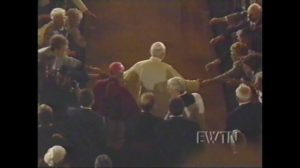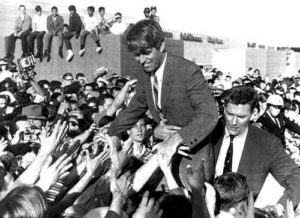Jesus was someone people wanted to touch and be touched by. But in the case of Jesus, such touches were about far more than the people’s desire to make contact with somebody famous. Jesus’ touch was said to have healing powers. As we can see in this story, some had concluded that Jesus was a type of magic object, a live wire who could give you a jolt of the divine whether he was aware of your touch or not.
It makes for a great story but notice how clever Mark was in composing it. Notice especially the role played by hands. Jairus does not simply ask Jesus to come and heal his daughter, he very specifically says, “Please come and put your hands on her.” In Mark’s gospel, Jesus has already performed any number of miracles that did not involve a physical touch. Yet Jairus very carefully requests the laying on of Jesus’ hands to bring about his daughter’s restoration.
As Jesus makes his way to Jairus’ house, a woman in the crowd touches Jesus to relieve her of a hemorrhage that had clearly consumed her life. So just after Jesus walks past her position in the larger crowd, she reaches out her hand, grabs a piece of his cloak, gives it a quick squeeze, and then lets go before she actually tugs on Jesus and so draws attention to herself. And she is instantly healed.
It’s surprising, isn’t it, that this method “works.” We ordinarily resist seeing Jesus as some kind of magic charm. We’d prefer to think that the miracles Jesus worked were done deliberately and as an act of his will. Reading this story for the first time, you wouldn’t expect this anonymous touching of Jesus to be effective. Yet it is.
Jesus notices that power had gone out from him, which is a curious way for Mark to put it. Lots of people were touching Jesus and jostling him at the time. Apparently none of them was tapping any divine power, however. why the disciples are rather incredulous when Jesus asks, “Who touched me?” If you’ve ever been in a crowded elevator making room for still more people who want to get into the car, you know what this is like. Everybody is touching somebody as you all shuffle sideways and back to let someone in or out. In that situation it would seem odd to say, “Who touched me?”
However, that question would make sense even in an over-crowded elevator in case you felt that someone was making a grab for the wallet in your back pocket or in case you had reason to believe someone was molesting you sexually. When you sense something beyond a typical jostle in the crowd, you ask about it. In Mark 5 it’s the same for Jesus: someone had touched him with a purpose and that differentiated that touch from the general press of humanity that they were all enduring. So he asks about it. In 2008 I got to shake Barack Obama’s hand at a campaign event. Like others on the rope line, I had my hand extended but just as Obama got to me, he bent down to shake a little girl’s hand who was standing in front of me. Next thing I knew, my hand was right on top of the crown of Senator Obama’s head. I have a great picture of the glare a Secret Service agent gave me! Ordinary touching of the candidate’s hands drew no attention but this different (and unintended) touch got an agent’s attention! Some touches are different than others. So also in Mark 5.
The woman in question is mortified. And I am using that word “mortified” deliberately. She is literally scared to death. You see, she didn’t belong in that crowd to begin with. She, too, had been forced to jostle with lots of folks as she jockeyed for position. What those other people didn’t know, however, was that according to Jewish law, every person who came into contact with this woman had been made ceremonially unclean. When I was young, the nature of her illness would have been described delicately by my mother as “a female problem.” Back when I was a kid that was code for “Inquire no further.”
This woman had a “female problem” and according to ancient law, it made her an outcast. For the good of all, she needed to remain far away from other people because so long as her problem persisted, she carried the contagion of unholiness. Touch this woman or be touched by her, and you couldn’t go to God’s Temple for a week. n other words, if it becomes known that she was putting the community at risk, she could be stoned to death. She’s been socially dead for a dozen years now and although people might feel bad about that, there wasn’t anything they could do about it. But if she could not quietly accept her socially mortified status, the community would have no choice but to remove her forcibly before she did more damage.
So when Jesus singles her out as having touched him with a purpose, her joy at having been healed turns to instant dread. Just as her life was about to begin anew, it looked like it might end. That is why she appears before Jesus with fear and trembling. She wasn’t afraid Jesus would rebuke her mildly by saying, “Next time ask first, OK?” The trouble she was in was far more grave than having been a tad presumptuous.
But to her credit, she tells what Mark describes as “the whole truth.” She could have lied, claiming she had sought healing for a bad cold or a sore back. But no, she admits the nature of her ailment and you can be well assured that the whole crowd had a collective sharp intake of breath. Suddenly every person there was wondering if he had rubbed shoulders with this woman. “Who knows how many people she had made unclean in the last ten minutes alone!” people no doubt began to murmur to one another.
But before the imminent panic got rolling, Jesus did an amazing thing: he called this woman “Daughter” and sent her away with a benediction. Jesus restored her to the community and so conveyed to everyone that the contagion of holiness that Jesus bore was now more powerful and more important than any potential contagion of unholiness that anyone else could possibly bear. And apparently it was enough to cleanse the whole crowd of people who had, technically, been ceremonially contaminated by her, too.
But that’s Jesus for you. Wherever he went he brought not only healing but he created again and again a whole new community, a whole new way to live together as sons and daughters of God.
Illustration Idea
Some years ago following the death of Pope John Paul II, the media ran many series of videos and photographs encapsulating the late pontiff’s career. Again and again what we saw in all that was the fact that no matter where the pope went, the one constant was the fierce desire people had to touch him. The New York Times published a particularly wonderful photo that showed this. It came from a visit the pope made to this country and specifically an appearance he made at a cathedral in Newark, New Jersey. The picture had been taken from the balcony and showed the pope from above and behind as he proceeded up the church’s center aisle. John Paul had both of his arms extended outward to the side. And from the pews lining the aisle were the extended hands of dozens of people stretching and reaching so that their hands could brush against one of his hands.

Recently we somberly marked the 50th anniversary of the assassination of Robert F. Kennedy and so were reminded that RFK exuded a similar attraction. According to Bobby Kennedy’s aides, there were many times after campaign appearances in 1968 when Bobby had to throw away his shirt. So many people clutched and clawed to touch him that Bobby’s hands would be scratched and a bit bloody even as his shirt sleeves became tattered to shreds.
Far better than just seeing someone—including someone powerful or famous—is to make contact. That’s something Jesus knew a lot about, too.

Dive Deeper
This Week:
Spark Inspiration:
Sign Up for Our Newsletter!
Insights on preaching and sermon ideas, straight to your inbox. Delivered Weekly!
Sermon Commentary for Sunday, July 1, 2018
Mark 5:21-43 Commentary